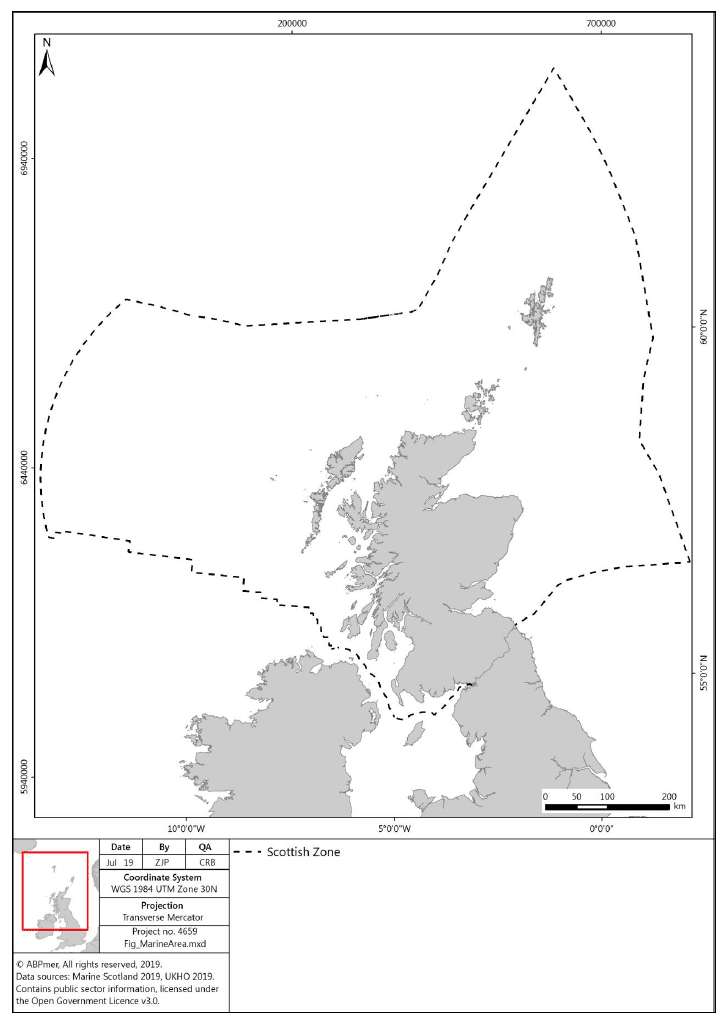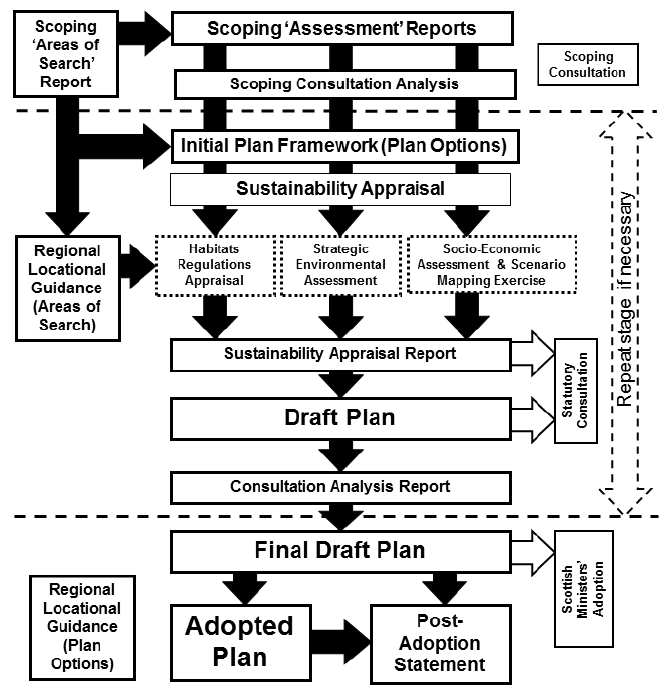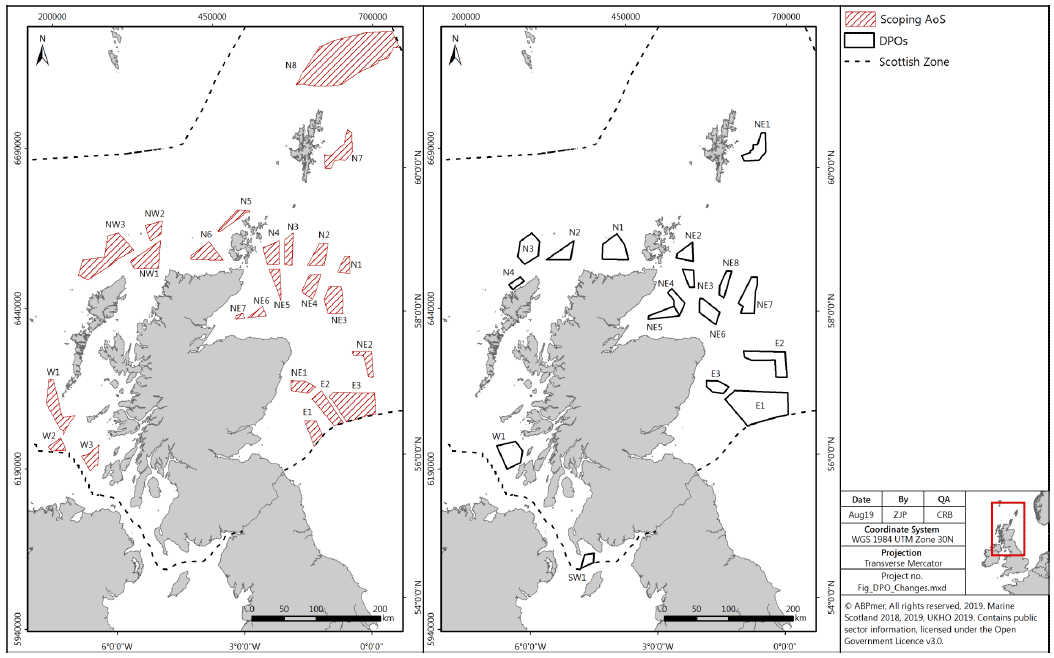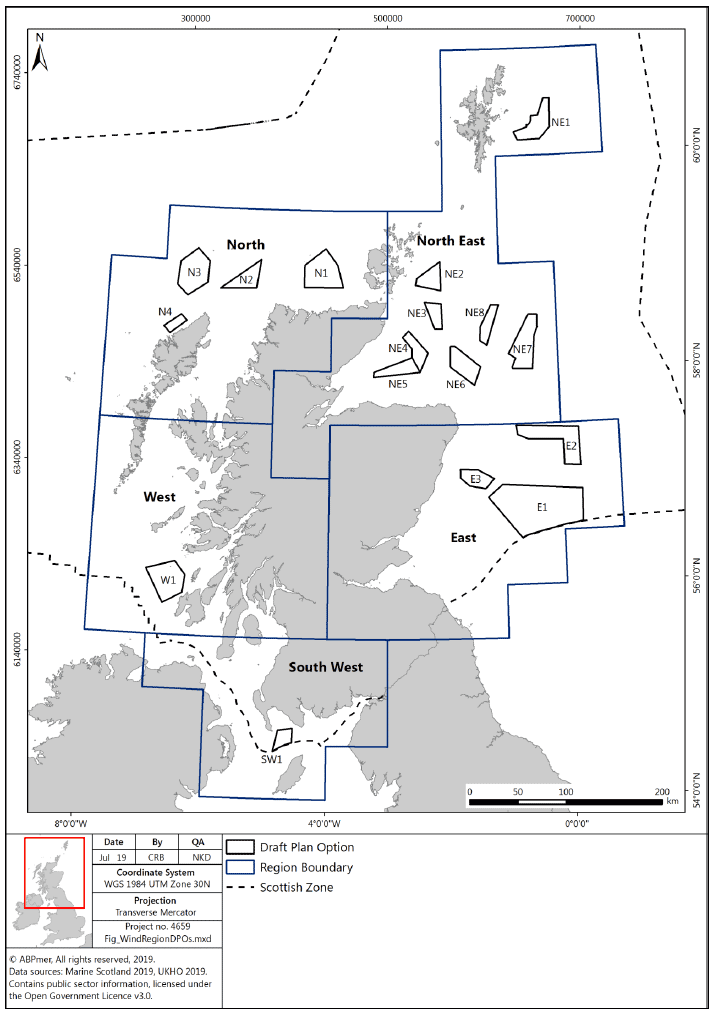Offshore wind energy - draft sectoral marine plan: sustainability appraisal
The sustainability appraisal considers the potential environmental, social and economic effects of the sectoral marine plan, including potential development scenarios and alternatives to them, drawing on information contained in the SEA, HRA and SEIA.
1 Introduction
1.1 Background
1.1.1 The Scottish Government is developing a plan for future commercial (defined as >100 MW arrays) offshore wind development in Scottish waters in the period to 2050. The plan builds on the previous draft plan for offshore wind published in 2013[1] and seeks to provide opportunities for deep water wind technologies which may become commercially viable over this time period as well as further opportunities for fixed bottom technologies.
1.1.2 The geographical scope of the plan covers Scottish Waters (0-200 nautical miles). This includes Scottish Territorial Waters (0-12 nautical miles) and the Scottish Offshore Marine Area (12-200 nautical miles) which is executively devolved to Scottish Ministers under the Marine and Coastal Access Act 2009 (Figure 1). The plan is being developed in accordance with Marine Scotland's sectoral marine planning process (Figure 2). The National Marine Plan[2] refers to this process in plan policy renewables 1. Once adopted, it is intended that the plan will also be reflected in the preparation or revision of relevant Regional Marine Plans.
1.1.3 An informal public consultation on the initial stages of development of the Draft Plan was held in June 2018[3]. This included the following documents:
- Context Report[4];
- Social and Economic Impact Assessment scoping report[5];
- Habitats Regulations Appraisal (HRA) Pre-screening Report[6];
- Strategic Environmental Assessment Screening and Scoping Report[7]; and
- Areas of Search Scoping Report[8].
Figure 1 Map of Scottish zone

Figure 2 Marine Scotland's sectoral marine planning process

1.1.4 Currently the majority of offshore wind farms have been built using conventional fixed bottom substructure technology. The maximum depth considered economically and technically feasible for these to be installed is approximately up to 60 m depth[9]. This depth limitation significantly constrains the amount of seabed space that can be exploited in Scottish waters. New floating wind turbine technology attached to the seabed by chains and anchors can potentially open up new areas of sea as they are theoretically not limited by depth. At present the maximum depth considered for offshore deployment is 800 m as expressed by Statoil in reference to its Hywind technology[10]. Construction and deployment prices of floating foundations may eventually compete with those of fixed bottom technologies[11], if floating wind sees a similarly rapid cost reduction to that which has taken placed in the fixed foundation wind industry.
1.1.5 In order to provide space for the potential development of fixed bottom and deep water offshore wind options, the Areas of Search Scoping study considered the full range of water depths down to 800 m. Full details on the criteria applied in the development of the Areas of Search are provided in the Scoping report[12].
1.1.6 The Scoping report identified an initial 24 Areas of Search (AoS) (Figure 3) that could provide suitable locations for conventional and deep water wind options. These 24 AoS were subsequently reviewed and updated, resulting in the identification of 17 Draft Plan Options (DPO) taken forwards for further assessment (Figure 3 and reproduced to provide increased detail in a larger image in Figure 4). A full description of the process undertaken to identify the 17 DPOs is included in Section 1.2 below.
1.1.7 As part of the plan development process, Regional Locational Guidance (RLG) has been prepared[13] to provide a baseline for environmental, technical, socio-economic and planning issues in relation to the DPOs. The RLG has grouped the DPOs into five broad geographic regions (South West, West, North, North East and East).
Figure 3 Evolution of AoS to DPOs

Figure 4 RLG offshore wind regions and DPO areas

1.2 Identification of Draft Plan Options
1.2.1 The sectoral marine planning process (as shown in Figure 2) is an iterative process, informed through stakeholder engagement and evidence from the related social, economic and environmental assessments. All of the information and consultation feedback gathered supports the Scottish Ministers in identifying Draft Plan Options (DPOs) to progress to the next phase of the plan process.
1.2.2 The DPOs have emerged through an examination of spatial data considerations in addition to advice and other related information provided by members of the Steering Groups, as well as stakeholders
1.2.3 The key stages of the planning process in relation to the identification of the Draft Plan Options, described in greater detail below, are:
- Opportunity and Constraint (O&C) Analysis - Iteration 1.
- Opportunity and Constraint (O&C) Analysis - Iteration 2 - Single Issue Constraint Analysis.
- Scoping Consultation.
- Opportunity and Constraint (O&C) Analysis - Iteration 3.
- Identification of Draft Plan Options.
- Next Steps.
Opportunity and Constraint (O&C) Analysis - Iteration 1
1.2.4 The identification of initial Areas of Search (AoS) was carried out through the use of an O&C analysis. It built upon previous work carried out by Marine Scotland Science in 2011 and the production of draft regional locational guidance for potential deep water floating offshore wind test sites in 2014. The analysis was iterative, so updates could be incorporated as required in order to reflect stakeholder feedback.
1.2.5 Full details of the O&C analysis can be found in the AoS scoping report published for consultation in 2018. The O&C analysis sought to identify areas of opportunity for the future development of offshore wind, whilst also identifying areas that minimised potential adverse effects on the environment, other sectors and users of the sea. This analysis was completed through the use of GIS and numerous spatial data resources.
Opportunity and Constraint (O&C) Analysis - Iteration 2
1.2.6 Sectoral engagement workshops were held in spring 2018. The AoS were then refined with consideration to specific spatial issues and feedback from the workshops.
1.2.7 This refinement process identified a range of distinct AoS (Figure 3). As the Draft Plan is technology neutral, no commercial or technology specific information was used in this refinement process.
Scoping Consultation - Screening and Scoping Reports
1.2.8 Scottish Ministers then consulted on the screening and scoping stages of the Plan process during June and July 2018. Screening and scoping reports were prepared and published online for the SEA, HRA and SEIA alongside the AoS scoping study.
Opportunity and Constraint (O&C) Analysis - Iteration 3
1.2.9 Iteration 3 of the O&C analysis was undertaken, which considered the responses received during the Scoping Consultation. For more details see the Consultation Analysis.
1.2.10 The AoS were refined with consideration to the outputs of the Iteration 3 O&C Analysis. As a result, certain AoS were either removed or refined to avoid/incorporate certain areas of Scottish Waters.
1.2.11 This stage also considered the areas of seabed proposed by stakeholders via the scoping consultation. A number of the areas proposed overlapped with existing AoS, while others overlapped with areas with higher levels of constraint or entirely new areas.
1.2.12 Upon review of the above information, a number of areas were identified to move forward in the plan process. Accordingly, some additional areas were included at this stage, where there was significant stakeholder interest, but also increased constraint. The Sustainability Appraisal stage has assessed these areas in greater detail.
Identification of Draft Plan Options
1.2.13 The 22 revised Areas of Search were made available to the Sectoral Marine Plan Project Board and two Project Steering Groups for consideration and comment.
1.2.14 Responses from both the Board and Steering Groups, together with the outputs of the initial assessments, were presented to Scottish Ministers to inform their decision on which AoS should progress to the Sustainability Appraisal for more detailed assessment.
1.2.15 Seventeen revised AoS were selected as DPOs (Figure 4).
Next Steps
1.2.16 Following the statutory consultation, the responses received will be subject to consultation analysis. This analysis will be considered by Scottish Ministers' and inform their decision on which Options to take forward in the Final Plan.
1.2.17 It should be noted that if significant changes are required as a result of the consultation feedback, further assessment and consultation may be required prior to adoption and publication of the Final Plan. The Post Adoption Statement (to be published with the Final Plan) will detail any changes made to the Plan as a result of consultation feedback.
1.3 Sustainability Appraisal
1.3.1 The Marine and Coastal Access Act 2009 (Schedule 6 s10) requires that "a marine plan authority preparing a marine plan must carry out an appraisal of the sustainability of its proposals for inclusion in the plan".
1.3.2 The SA considers the potential environmental, social and economic effects of the Sectoral Marine Plan, including potential development scenarios and alternatives to them, drawing on information contained in the SEA[14], HRA[15] and SEIA[16]. It ensures that decision-making is informed by relevant environmental and socio-economic information. The SA also provides opportunities for the public to consider this information and use it to inform their views.
1.3.3 The SEA has been undertaken in fulfilment of The Environmental Assessment (Scotland) Act 2005 ("the 2005 Act") which requires that certain public plans, programmes and strategies be assessed for their potential effects on the environment.[17]
1.3.4 The SEIA has been undertaken as a matter of Scottish Government policy. The SEIA investigates the potential cumulative positive and negative economic impacts, and associated potential social impacts, of development under the Sectoral Marine Plan.
1.3.5 The findings from the SEA, the HRA and the SEIA have been combined to provide an overall SA of the Sectoral Marine Plan, to accompany the consultation document. The inputs from the SEA[18] alongside the conclusions of the HRA[19] have informed the 'Environment' sections of the SA. The inputs from the SEIA[20] have informed the 'Economy and Other Marine Users', 'Potential Positive Economic Impacts' and 'Social Impacts on Individuals, Communities and Society' sections of the SA.
1.3.6 The views of the public, the Consultation Authorities and the Consultation Bodies on the proposed Sectoral Marine Plan and the findings of this SA Report are now being sought.
1.3.7 The remainder of this report is structured as follows:
Contact
Email: drew.milne@gov.scot
There is a problem
Thanks for your feedback